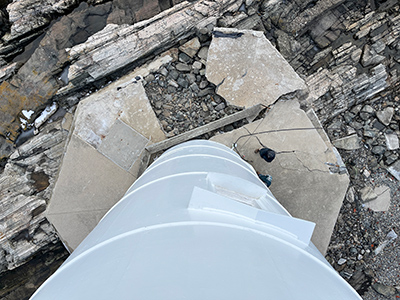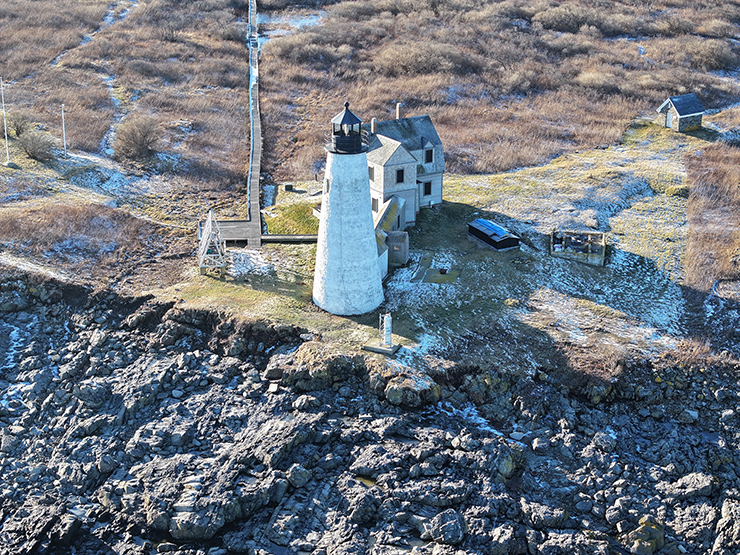
Storm seas at Pemaquid Point.
(Photo by Bob Trapani, Jr.)
Powerful storms, including legendary northeast gales, have historically battered the New England coast. Harrowing is their fury that overwhelms for hours – if not days. Wreckage is the lot of the communities who happen to be in harm’s way.
In the wake of each mighty tempest, the damage to working waterfronts and coastal infrastructure can be quite sobering, even disheartening. The riveting scenes are etched evermore in the minds of people impacted by such storms.
Headlines convey the awful news far and wide, while accompanying images and video reinforce the depth of destruction to its astonished following. The shock may be profound, but it’s hardly enduring.

A powerful winter storm destroyed the 50-foot Shag Rock Daybeacon 9 near Owls Head Light in 2023.
(Photo by Bob Trapani, Jr. photo)
For it is the inherent nature of the news cycle – as well as the attention span of the public, to become distracted by a wave of dramatic events occurring in the next instant. Stories of significance mere days prior can quickly fade from the consciousness of people.
The same holds true for lighthouses. No matter how destructive a weather event proves to be, the focus on the harm it caused is simply not sustainable. Yet, just because our minds have moved on to other community, state or national happenings, does not change the reality for adversely impacted lighthouses.
Lighthouses do not move on. Lighthouses do not go anywhere. On the contrary, these historic sentinels continue to stand watch in their battered actuality – and amid a sea of uncertainty as to their future.

Storm seas hammered Cuckolds Lighthouse during January 2024.
(Photo by Benjamin Williamson)
Ten months has passed since the winter storms of January 10 and 13, 2024, devastated the Maine and New Hampshire coastline. Yet, in many cases, the terrible effects from these storms remain unabated. The reasons for this reality are as complex as they are elusive.
Of course, funding can be a significant hurdle for any disaster recovery project, but money alone is not the only conundrum. Partnering with professional resources – engineers, architects and historic preservation contractors, in a timely fashion, can be challenging. There are only so many qualified service providers to draw upon when widespread destruction happens.
There is also processes for storm-damaged projects to go through before emergency stabilization repairs – and permanent repairs, can be approved for implementation. The consultation process can be lengthy and unforeseen factors often add to the delay of a project proceeding in an expedient manner.

The January 2024 storms wreaked havoc on the base of the lighthouse and oil house at Portsmouth Harbor, NH.
(Photo by Bob Trapani, Jr.)
The plight of Portsmouth Harbor Lighthouse in New Castle, New Hampshire, is a case in point. The January 2024 storms caused significant damage to the base of the light tower and the station’s brick oil house.
While furious seas hammered the light station, a three to four foot storm surge inundated the lighthouse and surrounding area, including U.S. Coast Guard Station Portsmouth and Fort Constitution.
The effects of the storm surge were nearly unprecedented and proved quite devastating. To make matters worse, damage to the historic structures and grounds has been exacerbated by subsequent astronomical high tides every month thereafter.

Since the January 2024 storms, big tides have continued to exact their toll on the concrete collar and foundation of Portsmouth Harbor Lighthouse.
(Photo by Bob Trapani, Jr.)
Portsmouth Harbor Light’s situation has gone from bad to worse with the passage of time. For storm damage at water’s edge never remains status quo. The relentless tides and wind will continue to erode the injured condition of any structure.
The delay in addressing the storm damage at Portsmouth Harbor Light Station is not for a lack of attention, but rather the process of going through disaster recovery procedures and obtaining the necessary authorizations to proceed.
Thankfully, there is light at the end of the tunnel for Portsmouth Harbor Lighthouse as the authorization process is drawing to a conclusion. Emergency stabilization repairs are expected to receive approval and be carried out before the end of 2024 – and not a moment too soon as the 2024-25 storm season is upon us.

ALF’s Friends of Wood Island Lighthouse have carried out emergency repairs on the storm-damaged boathouse.
(Photo by Kyle Noble)
However, at some lighthouses, temporary repairs will be asked to carry the day for a longer period of time than originally anticipated. And they are the lucky ones. Others light stations still have unchecked erosion concerns, compromised access points and historic structures left waiting for repairs to be carried out.
Will these damaged light station structures endure and survive another storm season? The answer is questionable.
Therefore, our response to the dangers that storms and rising sea levels pose to lighthouses cannot be a momentary effort. If historic light stations are to endure well into the future, hazards from severe weather must be mitigated and the structures made more resilient. Nothing less than a tenacious and resourceful approach in the present will do.
To learn what the American Lighthouse Foundation and its Storm and Mitigation Committee is doing to help light stations become more resilient – and how you can support these efforts, visit ALF’s Lighthouses & Climate Change page.

Unchecked erosion, exacerbated by powerful storms, continues to threaten Maine’s 1839 Wood Island Lighthouse. (Photo by Josh McPhail)

